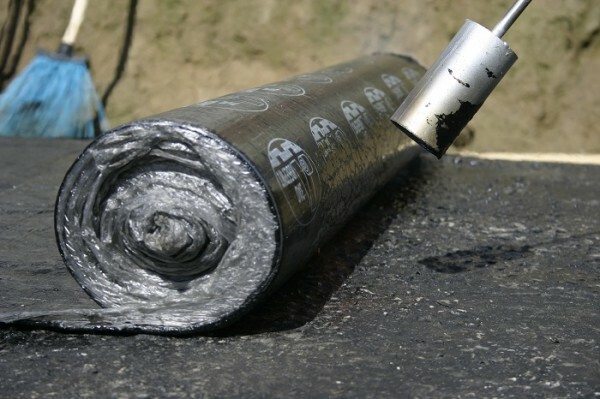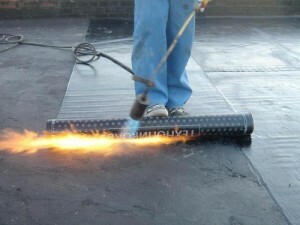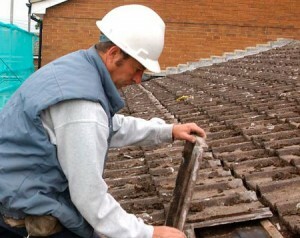Choosing insulation for roofs - 5 advanced options
Table of contents
- 1 The nuances of the selection of a heater
-
2 types of heaters
- 2.1 Material 1: rockwool
- 2.2 Material 2: polystyrene
- 2.3 Material 3: The extruded polystyrene
- 2.4 4 Material: polyurethane
- 2.5 Material 5: ecowool
- 3 Output
How to choose insulation for the roof, to be effective, and quality? I will talk about the five most common types of thermal insulation materials that are suitable for thermal insulation of the roof. In addition, you will learn what parameters to look for when choosing.

Insulation for the roof must be effective and durable
The nuances of the selection of a heater
How to choose insulation? When you select should be given to the following parameters:
- Life time. Insulation should be a long time to maintain its insulating qualities;
- Stable shape and volume. From this it depends on the effectiveness of insulation;
- Frost. The material should not lose its properties at differences of air temperature;
- Soundproofing. This parameter is important for roofing made of "noisy" coatings, such as metal or corrugated board;
- Environmentally friendly. Insulation should not be toxic, especially if it is used to insulate the attic.
In addition to the parameters of the insulation should be given to the producer and the material. Refuse to purchase a cheap insulation from little-known companies. Well-established brand and the value of their products I will mention below.
Violation of storage conditions can adversely affect the performance of the insulation. So do not make a purchase in the markets and in small shops, where materials storage conditions may be violated.
types of heaters

All the requirements set out above correspond to the following materials for the thermal insulation of the roof:
Next, learn more about all kinds of thermal insulation materials.
Material 1: rockwool
Mineral wool is rolled or slab insulation is formed thin, intertwined mineral fibers. Recent prepared from the silicon melt, blast furnace slag, basalt and other rocks.
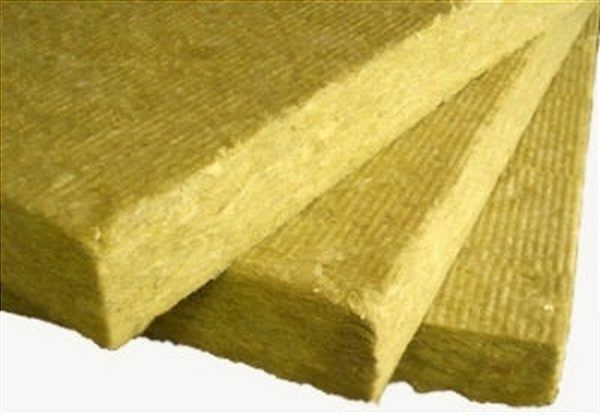
Mineral wool - fire-safe and eco-friendly insulation for roofs
I must say that among all types of mineral wool highest quality - basalt insulation. Therefore, for roof insulation I recommend to use it.
dignity:
- Thermal conductivity. Depending on the density of the thermal conductivity with 0,076-0,12 W / (m · K);
- The water vapor permeability. This quality allows moisture to go through the insulation to the outside;
- Fire safety. Mineral wool is not lit, and withstands heating to a temperature of 700-1000 degrees, in other words - the combustion heater is able to withstand;
- Environmentally friendly. The composition of the basalt wool does not contain harmful substances. However, this applies only to materials from reputable manufacturers;

Mineral wool can insulate the flat roof
- Versatility. Mineral wool can be used not only for a pitched roof, but also plane, by laying under the screed, due to its high compressive strength. The only thing for it is necessary to use high-density mats;
- Lifetime. Basalt wool will last more than 70 years;
- Compressive strength. This figure may reach 0.3 MPa;
Disadvantages. Cons in stone wool is not much:
- The ability to absorb moisture. This increases the thermal conductivity, however, after drying the insulating quality of the material returned. Therefore, mineral wool requires installation of waterproofing;
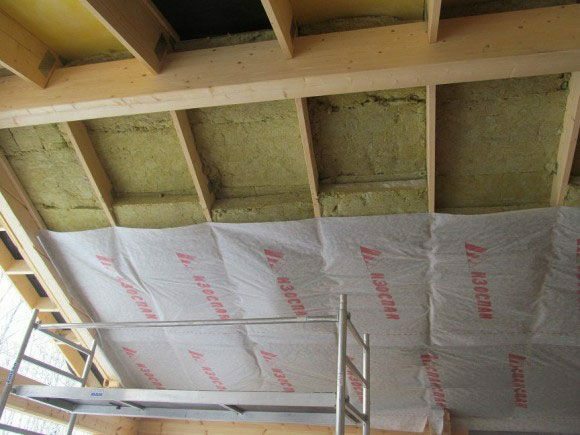
Mineral wool needs quality waterproofing
- Cost. Stone wool is more expensive than many other insulation materials;
- Shrinkage. Plates with a low density may shrink. This nuance need to be checked with the manufacturer.
I must say that, in principle, for thermal insulation of the roof can be used and cheaper types of mineral wool, for example, glass wool or slag wool. However, it should be noted that these materials are not environmentally friendly. In addition, slag wool and glass wool shrink more than basalt wool.
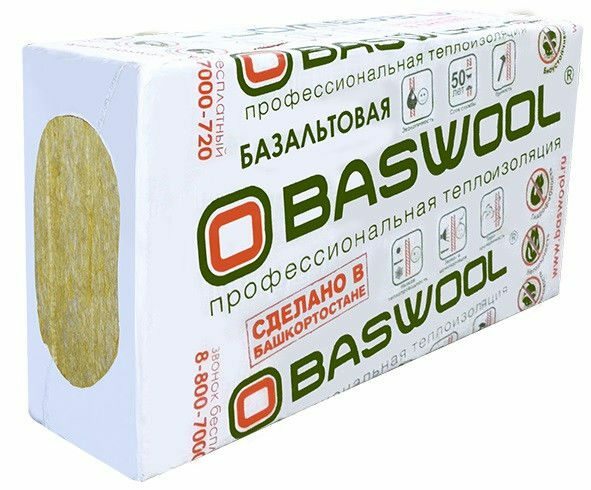
Minvata BASWOOL - high-quality and relatively inexpensive heater
Cost. Below are the prices for basalt wool from manufacturers that have proved themselves on the market:
| Mark | The cost in rubles per 1m3 |
| BASWOOL (90 kg / m3) | 2730 |
| Rockwool (90 kg / m3) | 4000 |
| Isoroc (60 kg / m3) | 2400 |
| PAROC FAS 3 (110 kg / m3) | 4850 |
In my opinion, mineral wool - is the best material for the roof insulation.

Expanded polystyrene has a granular structure consisting of pellets filled with air. This provides good characteristics and its performance characteristics
Material 2: polystyrene
Expanded polystyrene (foam) - this is a popular polymer material for thermal insulation of the roof.
dignity:
- Low weight. The density is in the range of 15-25 kg / m3, so the foam is the easiest of all the heaters;
- Thermal conductivity. Coefficient, depending on the density is in the range 0,032-0,044 W / (m K);
- Low cost. The foam can be attributed to the category of cheap heaters;
- Versatility. As mineral wool, the material can be used for insulating flat roofs.
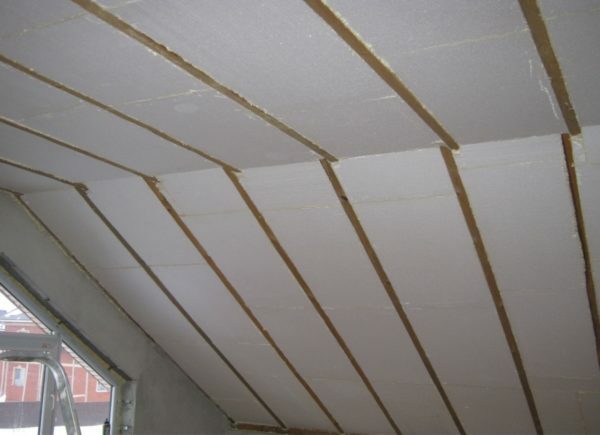
Insulation of roofing polystyrene cost is not expensive compared to other heaters
disadvantages:
-
Zero vapor permeability. As a result of this deficiency, moisture can accumulate between the insulation and rafters that will cause them to rot.
Therefore, in the case of roof insulation foam, must seal the heater and the inner side of the rafters. During installation, a vapor barrier is required to pay attention to the sealing of the joints of fabrics. Even small cracks may lead to the penetration of moisture, so the joints must prokleivat double sided adhesive tape;

Expanded polystyrene is well lit and releases the toxins at the same time
- Fire hazard. Expanded polystyrene is usually well lit;
- Low environmental friendliness. In the process of combustion releases toxic substances;
- Lifetime. On average, the foam is about 40 years;
- Low strength. It is within 0.05-0.1 MPa.
cost of. The price of the foam depends on its density:
| Mark | Price per 1m3 |
| DPM-35 C | 2900 |
| PSB-S-25 | 2300 |
| DPM C-15 | 1400 |

Extruded polystyrene - more durable polymer insulation, and this is valuable
Material 3: The extruded polystyrene
Extruded polystyrene foam, also known as penoplex - is another polymer insulation, which is made from the same material as a conventional polystyrene. However, as a result of a special technology different characteristics for the better.
dignity:
- High strength. The compressive strength of the insulation 10 times higher than the strength of the foam. Through this penoplex one of the best insulation for flat roofs
- Moisture resistance. The material hardly absorbs moisture;

Penoplex does not absorb moisture
- Thermal insulation quality. Thermal conductivity coefficient even lower than that of the foam - about 0.03 W / (m K);
- Durability. Penoplex can last more than 50 years;
- Fire safety. All known manufacturers add flame retardants in polystyrene, thus becoming readily flammable material.
disadvantages:
- High price. The insulation for the roof is one of the most expensive;
- Low vapor permeability. This disadvantage has all of the polymer insulation for the roof;
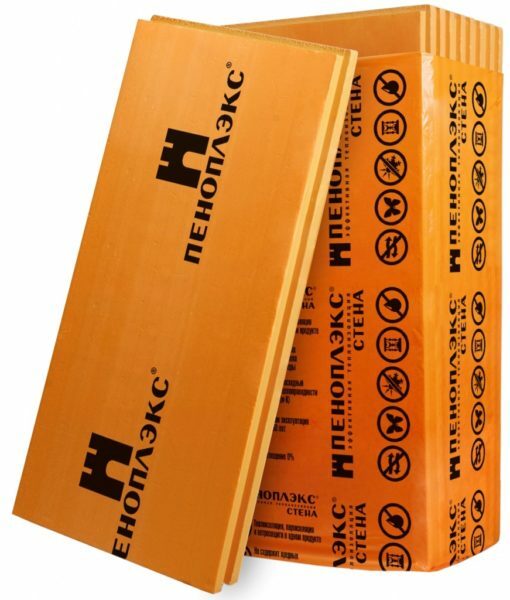
Penoplex - one of the most well-known domestic manufacturers of extruded polystyrene foam, and one of the most expensive
Cost. Price depends on the manufacturer:
| Mark | price, rub. per 1m3 |
| TECHNOPLEX | 4610 |
| TECHNONICOL CARBON | 4700 |
| URSA XPS | 4350 |
| Penoplex | from 4300 |
Therefore, it makes sense to use polystyrene only where it will be provided to the load.
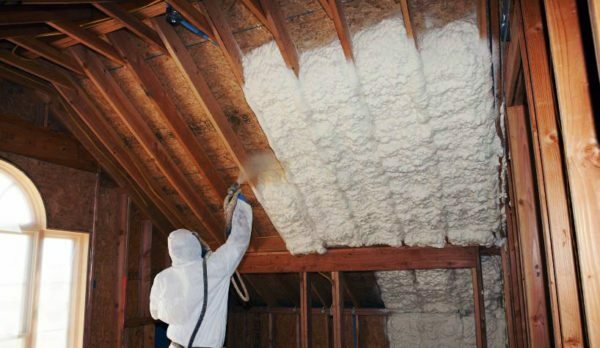
Polyurethane foam - the most effective polymer insulation
4 Material: polyurethane
Polyurethane foam - another polymer roofing insulation. Due to the good operating characteristics, it is widely used.
dignity:
- Low thermal conductivity. Due to the fact that the polyurethane foam cells filled with a gas, rather than air, it has a thermal conductivity insulation even lower than that of extruded polystyrene - thermal conduction coefficient of 0,028-003 W / (m K);
- It is applied as a foam. As a result, it forms a continuous layer of insulation without thermal bridges;
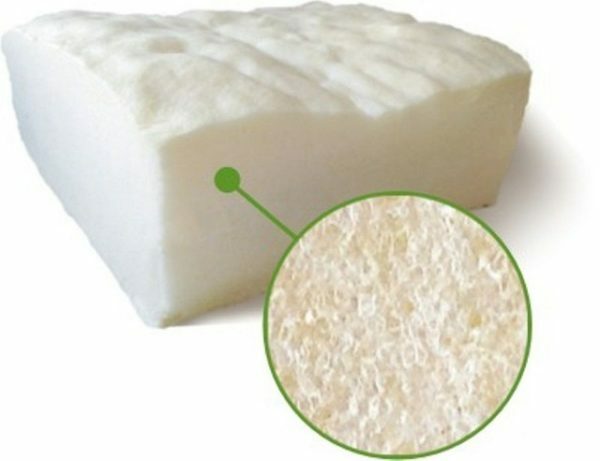
Polyurethane foam has a cellular structure, filled with a gas
- Good adhesion. This allows to apply to any type insulation surface;
- Fire safety. The composition of polyurethane flame retardants are added, making it readily flammable;
- Strength. According to this indicator is not inferior to the polyurethane foam extruded polystyrene;
- Moisture resistance. When properly applied polyurethane foam is not required the use of a vapor barrier, as the insulation itself protects wood structures from moisture.
disadvantages:
- Zero vapor permeability. This deficiency I mentioned above;
- The need for special equipment. Polyurethane foam to insulate the roof with their own hands will not work, because it requires special installation. Besides, the insulation of the process requires highly skilled craftsmen;

Plants for applying foam
- Limited application. Polyurethane foam can be used only for the internal insulation of pitched roof;
- Lifetime. 25-30 years;
- Increasing the thermal conductivity. Over time, the insulation gas leaves the cell as a result they are filled with air. This increases the thermal conductivity to the level of other polymeric insulation;
- High price. In addition to the cost of the insulation material, is added to the payment services professionals. The cost of polyurethane foam insulation the average is 500-600 rubles. per 1m2 with the work.
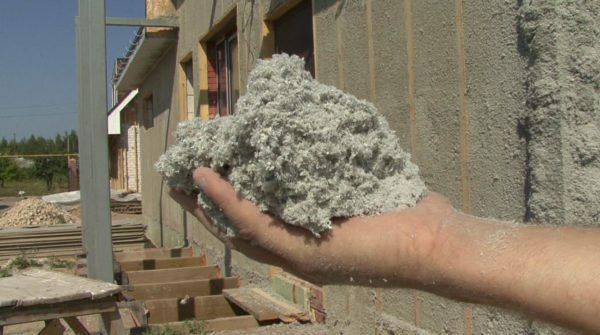
Ecowool - eco-friendly insulation based on cellulose
Material 5: ecowool
This insulation of the roof is made of cellulose, to be precise - newsprint, which occupies a part of 80%. The remaining 20% - are all possible additives which improve the properties of the material. Like cellulose itself, they are absolutely harmless to health, hence the name of the material.
Ways ecowool insulation surfaces there are several:
- Manual. Vata simply poured on horizontal surfaces. This method can only insulate the attic floor;
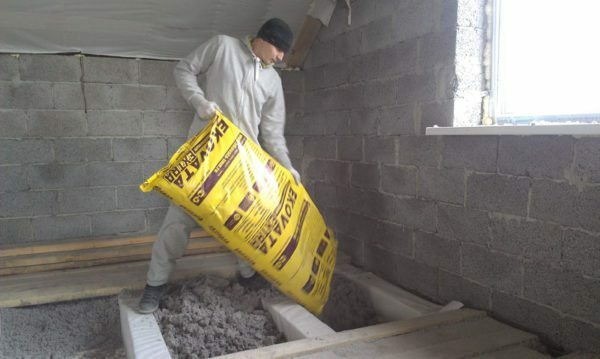
Manual mode can be insulated ceiling
- Automatic dry. Carried out with the help of special equipment. Its essence lies in the carcass processing by a vapor barrier structure and filling in dry ecowool of the frame through a hose as shown in the photo below.
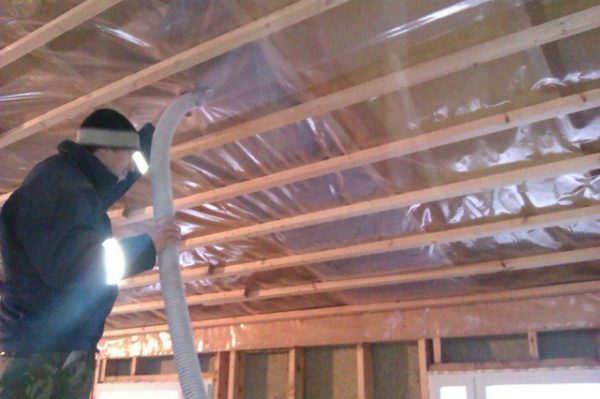
Warming dry method implies supply hose through ekovaty
In this way it is possible to insulate a pitched roof or gable.
- Automatic wet. In this case ecowool fed under pressure into the wet form. Due to the presence in the composition of the adhesive, insulation adheres well to surfaces. This method can be used for thermal insulation of flat surfaces and sloping roofs.

The wet method of coating ekovaty resembles the process with polyurethane foam insulation
To insulate the attic floor is cheap, you can use wood chips. Only to filings were resistant to rot, in the total weight should mix in 5-10% of the dry lime.
dignity:
- Environmentally friendly. If you do not know what kind of insulation to choose it to be absolutely harmless, the ecowool just what you need;
- The water vapor permeability. This index of insulation even higher than that of mineral wool;
- Fire safety. This property is provided by special additives, due to them also the material is not afraid of negative biological effects;
- Low cost. Ecowool one of the cheapest heaters that can be used for roofing;
- Durability. Manufacturers claim that the term Cellulose Fiber service is 100 years old.

Ecowool not ignite
disadvantages:
- The need for special equipment. Without equipment can only insulate the attic floor;
- The tendency to shrink. As a result of this lack of instruction on warming requires the application of Cellulose Fiber with a small surplus.
Cost. Price depends on the method of insulation. Heater bag 15 kg weighs 500 rubles. Warming automatic wet costs 1800-2000 rubles. per cubic meter.
That's all insulation materials, which I wanted to tell you. Now you only need to decide which one is best to choose a heater.
Output
We are familiar with all the most common heaters, it will help you to make your choice. Additionally, check out the video in this article. If you have any questions, please write them in the comments, and I will gladly answer.
